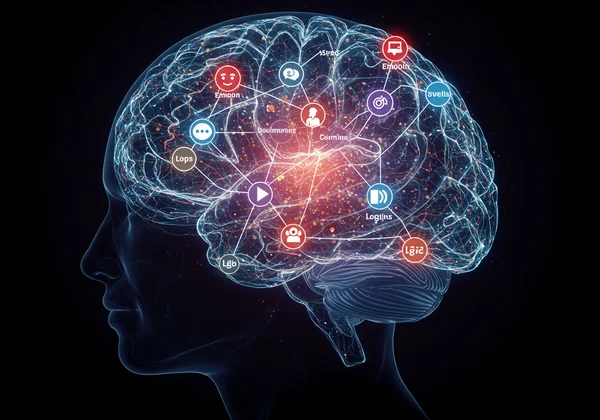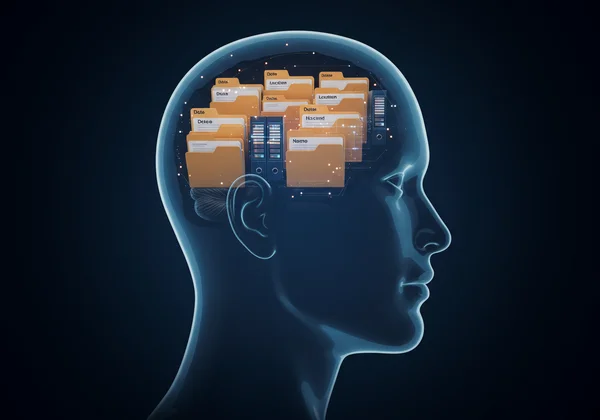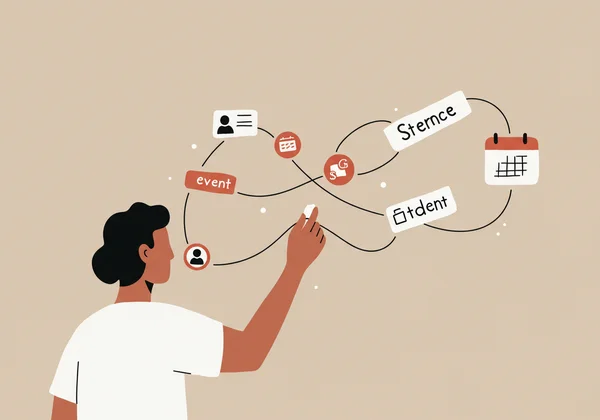Aphantasia and Memory: More Than a Simple Aphantasia Test
Discovering you might have aphantasia often triggers a cascade of questions. The most common and pressing one we hear is about aphantasia and memory. It’s a thought that can feel unsettling: "If I can't 'see' my memories, how do I remember anything at all?" This is a valid concern, and it touches the very core of how we understand our own minds. How do people with aphantasia remember things? The answer is fascinating, and it reveals the incredible adaptability of the human brain. Your memory isn't broken; it simply operates on a different, powerful set of principles.
The truth is, visual recall is only one piece of the vast puzzle of memory. For those with aphantasia, other systems work in overdrive to create a rich and detailed tapestry of the past. If you're questioning your own cognitive style, understanding it is the first step. Taking an aphantasia test is a great way to explore your mind's eye with a science-inspired self-assessment.
How Aphantasics Remember: Beyond the Mind's Eye
To understand memory in aphantasia, we must look beyond the concept of a mental photo album. The brain has multiple, interconnected memory systems, many of which are entirely non-visual. People with aphantasia, or a "mind's blindness," often develop highly sophisticated abilities in these other areas. This isn't a deficiency; it's a different way of processing the world, a unique cognitive profile that relies on facts, feelings, and concepts instead of pictures.

This realization can be incredibly empowering. It reframes the experience from one of lack to one of specialized strength. Understanding these systems is the key to appreciating how your mind expertly navigates the world and its past. Many people begin this journey of discovery with a simple aphantasia self-assessment.
Understanding Semantic Memory: Your Brain's Fact File
One of the most crucial systems for aphantasics is semantic memory. Think of it as your brain’s personal encyclopedia or fact file. It stores conceptual information, facts, and general knowledge about the world. When a visualizer recalls a trip to the beach, they might see the waves crashing. Someone with aphantasia might access a list of semantic facts instead: "The beach was in California. The date was July 10th. The weather was sunny, about 80 degrees. My friend Sarah was there. We ate sandwiches."

This system is incredibly efficient and detailed. It's not a vague sense of the past; it's a database of information. You don't need a picture of your grandmother to know her hair color, the sound of her laugh, or the fact that she made the best apple pie. You recall the knowledge of these things. This is your semantic memory at work, providing the "what" and "who" of your experiences without needing a visual "how."
The Power of Procedural and Spatial Memory
Next are two more non-visual powerhouses: procedural and spatial memory. Procedural memory is often called "muscle memory." It's how you remember to perform tasks and actions, like riding a bike, typing on a keyboard, or tying your shoes. You don't visualize the steps; your body simply knows what to do. This form of memory is deeply ingrained and functions independently of your mind's eye.
Spatial memory, meanwhile, is your internal map of the world. It’s the knowledge of where things are in relation to one another. You can navigate your house in the dark not because you "see" the furniture, but because you have a spatial awareness of the layout. Many aphantasics report a strong sense of direction and an excellent ability to understand maps and floor plans, as their brains are highly attuned to these spatial relationships rather than visual landmarks.
The Role of Conceptual and Emotional Recall
Finally, memories are not just facts; they are infused with feelings and concepts. This is where conceptual recall comes in. Instead of a visual snapshot, a memory might be stored as a collection of interconnected ideas and emotions. This is a core part of your unique cognitive style.
Here's a powerful example that encapsulates this experience: "I don't see my wedding day, but I remember the feeling of overwhelming joy. I remember the sound of the specific song we danced to, the conceptual knowledge that the flowers were lilies, and the distinct feeling of my partner's hand in mine." This demonstrates that a memory can be incredibly vivid and meaningful without a single visual component. The emotional and sensory data—sounds, smells, touch, and feelings—create a rich, multi-layered recollection that is just as valid and profound as a visual one. If this resonates with you, consider taking a free aphantasia test to learn more.
Proven Aphantasia Memory Techniques
Understanding how your memory works is the first step. The next is learning how to leverage its unique strengths. These aphantasia memory techniques aren't about trying to force visualization but about enhancing the powerful non-visual systems you already use. Think of it as upgrading your brain's existing software. By embracing these strategies, you can improve recall, learning, and confidence in your daily life.

These methods are designed to work with, not against, your natural cognitive tendencies. They focus on building connections, creating narratives, and using practical tools to support your fact-based memory. A great way to begin is by getting a baseline of your abilities through an online aphantasia test.
Strengthening Your Semantic Network with Association
Your semantic memory thrives on connections. To make new information stick, you need to consciously link it to the knowledge already stored in your "fact file." When you learn a new person's name, for instance, don't just repeat it. Associate it with facts you already know. If you meet a "David" who is an architect, you might think, "David the architect, who designs buildings, like the one I work in."
This process, known as elaborative rehearsal, builds a stronger neural pathway to the information. You can also use mnemonic devices that rely on words, rhymes, or acronyms rather than images. Creating these logical links strengthens your semantic web, making information easier to retrieve when you need it. This is a practical skill for anyone looking to improve their retention.
Leveraging Narrative and Storytelling
Humans are hardwired for stories. For those who don't think in pictures, creating a verbal narrative is an exceptionally powerful memory tool. Instead of trying to visualize a series of events, turn them into a story with a beginning, middle, and end. This technique transforms a dry list of facts into a coherent and engaging sequence that is much easier for your brain to encode and recall.
For example, when studying for a history exam, don't just memorize dates and names. Weave them into a story about the people involved, their motivations, and the consequences of their actions. This narrative structure provides context and logical flow, which are the cornerstones of a strong semantic memory. You're not just remembering facts; you're remembering the plot.
Using External Aids: From Notes to Journals
Embracing external memory aids is not a weakness; it's a smart strategy. In a world of information overload, everyone can benefit from offloading some cognitive burden. For aphantasics, tools like detailed note-taking, journaling, and photography can be particularly effective. They serve as an external database that complements your internal, non-visual one.
Keeping a journal allows you to record not just events, but also the feelings, thoughts, and sensory details associated with them. Taking photos helps capture a moment, and when you look at the photo later, it can trigger the rich semantic and emotional data connected to that event. These tools aren't a crutch; they are a powerful extension of your memory, allowing you to build a reliable and accessible archive of your life. This journey of self-assessment can help you pinpoint which tools work best for you.
Your Mind is Unique, Not Broken
Living with aphantasia means your brain recalls the past through a different lens—one built from facts, feelings, and conceptual links. Your memory isn't deficient; it's specialized in a different, equally valid way. Recognizing this is the first step toward harnessing your cognitive potential. Ready to explore your unique style? Take our free aphantasia test to understand your mind's eye and gain deeper insights into how your memory works.
Common Questions About Aphantasia and Cognition
What are common traits of people with aphantasia?
Beyond the inability to voluntarily visualize, many people with aphantasia report a few common traits. They often have a more conceptual, verbal, or logical thinking style, sometimes referred to as having a strong inner monologue. Some find they are skilled at abstract thinking, mathematics, or computer programming. Conversely, they may find tasks that heavily rely on visual memory, like recalling specific details of a room, more challenging. It's a spectrum, and every individual's experience is unique.
Do people with aphantasia have trouble remembering faces?
This is a common concern. Some individuals with aphantasia also experience Severely Deficient Autobiographical Memory (SDAM) or prosopagnosia (face blindness), but many do not. Aphantasics often remember faces using semantic data rather than a mental image. They might recall a person by their hairstyle, the sound of their voice, their distinct glasses, or a list of their facial features. They "know" what the person looks like without "seeing" them in their mind. If you're curious about where you fall, a VVIQ test online can offer a starting point.
What are people with aphantasia good at?
Many people with aphantasia discover they have heightened abilities in other areas. Because they rely less on mental imagery, they may develop stronger skills in abstract, conceptual, and logical thinking. Fields like philosophy, mathematics, and computer science can be a natural fit. Additionally, some report being more "present" in the moment, as they are not constantly comparing reality to a mental image of the past or future. This focus on the here-and-now can be a significant advantage in many personal and professional settings. You can discover your results and potential strengths with our assessment.
Disclaimer: This article is for informational purposes only and is not a substitute for professional medical, psychological consultation, or diagnosis. If you have concerns, please consult a qualified professional.